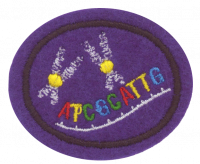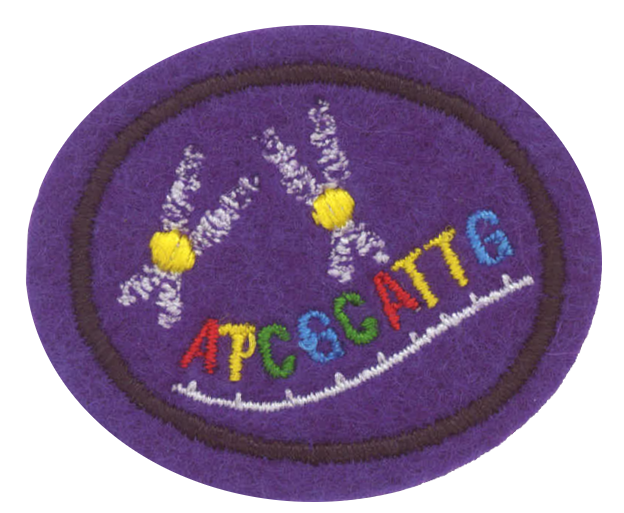Difference between revisions of "AY Honors/Heredity/Requirements"
Jomegat bot (talk | contribs) (Bot: Automated import of articles *** existing text overwritten ***) |
m |
||
| (12 intermediate revisions by 2 users not shown) | |||
| Line 1: | Line 1: | ||
| − | + | {{HonorSubpage}} | |
| − | |||
| − | |||
| − | + | <section begin=Body /> | |
| − | |||
| − | <b> | + | <b>1. <section begin=req1 /><noinclude><translate><!--T:1--> |
| − | < | + | </noinclude>What is meant by the term "heredity"? |
| + | <noinclude></translate></noinclude><section end=req1 /></b> | ||
| − | <b> | + | <b>2. <section begin=req2 /><noinclude><translate><!--T:2--> |
| − | <section end= | + | </noinclude>Draw a picture of an animal cell and label the following parts: Cell membrane, cytoplasm, nucleus, nuclear membrane, golgi bodies, ribosomes. |
| + | <noinclude></translate></noinclude><section end=req2 /></b> | ||
| − | <b> | + | <b>3. <section begin=req3 /><noinclude><translate><!--T:3--> |
| − | <section end= | + | </noinclude>Explain the following: |
| + | <noinclude></translate></noinclude><section end=req3 /></b> | ||
| − | <b> | + | :<b>a. <section begin=req3a /><noinclude><translate><!--T:4--> |
| − | < | + | </noinclude>What is a chromosome and where are they located? |
| + | <noinclude></translate></noinclude><section end=req3a /></b> | ||
| − | <b> | + | :<b>b. <section begin=req3b /><noinclude><translate><!--T:5--> |
| − | < | + | </noinclude>What is a gene and where is it found? |
| + | <noinclude></translate></noinclude><section end=req3b /></b> | ||
| − | <b> | + | <b>4. <section begin=req4 /><noinclude><translate><!--T:6--> |
| − | <section end= | + | </noinclude>Explain the following: |
| + | <noinclude></translate></noinclude><section end=req4 /></b> | ||
| − | <b> | + | :<b>a. <section begin=req4a /><noinclude><translate><!--T:7--> |
| − | <section end= | + | </noinclude>What is meant by the term "allele"? |
| + | <noinclude></translate></noinclude><section end=req4a /></b> | ||
| − | <b> | + | :<b>b. <section begin=req4b /><noinclude><translate><!--T:8--> |
| − | <section end= | + | </noinclude>How does a dominant allele differ from a recessive allele? |
| + | <noinclude></translate></noinclude><section end=req4b /></b> | ||
| − | <b> | + | :<b>c. <section begin=req4c /><noinclude><translate><!--T:9--> |
| − | <section end= | + | </noinclude>Determine which allele you have of the following genetic traits: |
| + | <noinclude></translate></noinclude><section end=req4c /></b> | ||
| − | <b> | + | ::<b>i. <section begin=req4ci /><noinclude><translate><!--T:10--> |
| − | <section end= | + | </noinclude>Widow's Peak |
| + | <noinclude></translate></noinclude><section end=req4ci /></b> | ||
| − | + | ::<b>ii. <section begin=req4cii /><noinclude><translate><!--T:11--> | |
| − | + | </noinclude>Free Earlobe | |
| + | <noinclude></translate></noinclude><section end=req4cii /></b> | ||
| + | |||
| + | ::<b>iii. <section begin=req4ciii /><noinclude><translate><!--T:12--> | ||
| + | </noinclude>Dimples | ||
| + | <noinclude></translate></noinclude><section end=req4ciii /></b> | ||
| + | |||
| + | ::<b>iv. <section begin=req4civ /><noinclude><translate><!--T:13--> | ||
| + | </noinclude>Curved Thumb | ||
| + | <noinclude></translate></noinclude><section end=req4civ /></b> | ||
| + | |||
| + | ::<b>v. <section begin=req4cv /><noinclude><translate><!--T:14--> | ||
| + | </noinclude>Bent Pinky | ||
| + | <noinclude></translate></noinclude><section end=req4cv /></b> | ||
| + | |||
| + | ::<b>vi. <section begin=req4cvi /><noinclude><translate><!--T:15--> | ||
| + | </noinclude>Digit Hair | ||
| + | <noinclude></translate></noinclude><section end=req4cvi /></b> | ||
| + | |||
| + | ::<b>vii. <section begin=req4cvii /><noinclude><translate><!--T:16--> | ||
| + | </noinclude>Rolling Tongue | ||
| + | <noinclude></translate></noinclude><section end=req4cvii /></b> | ||
| + | |||
| + | ::<b>viii. <section begin=req4cviii /><noinclude><translate><!--T:17--> | ||
| + | </noinclude>Second Toe Longer | ||
| + | <noinclude></translate></noinclude><section end=req4cviii /></b> | ||
| + | |||
| + | :<b>d. <section begin=req4d /><noinclude><translate><!--T:18--> | ||
| + | </noinclude>Using a punnett square, predict the ratio of offspring produced from these monohybrid crosses: TT (tall) crossed with tt (short), Tt (tall) crossed with Tt (tall), Tt (tall) crossed with tt (short). | ||
| + | <noinclude></translate></noinclude><section end=req4d /></b> | ||
| + | |||
| + | <b>5. <section begin=req5 /><noinclude><translate><!--T:19--> | ||
| + | </noinclude>Explain the following: | ||
| + | <noinclude></translate></noinclude><section end=req5 /></b> | ||
| + | |||
| + | :<b>a. <section begin=req5a /><noinclude><translate><!--T:20--> | ||
| + | </noinclude>What does the process of mitosis accomplish? | ||
| + | <noinclude></translate></noinclude><section end=req5a /></b> | ||
| + | |||
| + | :<b>b. <section begin=req5b /><noinclude><translate><!--T:21--> | ||
| + | </noinclude>Draw a sequence of cells that shows the process of mitosis including: prophase, metaphase, anaphase, and telophase. | ||
| + | <noinclude></translate></noinclude><section end=req5b /></b> | ||
| + | |||
| + | :<b>c. <section begin=req5c /><noinclude><translate><!--T:22--> | ||
| + | </noinclude>Briefly explain how the DNA in the chromosomes is copied during this process. | ||
| + | <noinclude></translate></noinclude><section end=req5c /></b> | ||
| + | |||
| + | <section begin=challenge /> | ||
| + | <b>6. <section begin=req6 /><noinclude><translate><!--T:23--> | ||
| + | </noinclude>Explain the following: | ||
| + | <noinclude></translate></noinclude><section end=req6 /></b> | ||
| + | |||
| + | :<b>a. <section begin=req6a /><noinclude><translate><!--T:24--> | ||
| + | </noinclude>What does the process of meiosis accomplish and how does it differ from mitosis? | ||
| + | <noinclude></translate></noinclude><section end=req6a /></b> | ||
| + | |||
| + | :<b>b. <section begin=req6b /><noinclude><translate><!--T:25--> | ||
| + | </noinclude>Draw a sequence of cells that shows the process of meiosis including: prophase I & II, metaphase I &II, anaphase I & II, and telophase I & II. | ||
| + | <noinclude></translate></noinclude><section end=req6b /></b> | ||
| + | |||
| + | :<b>c. <section begin=req6c /><noinclude><translate><!--T:26--> | ||
| + | </noinclude>Do the cells resulting from meiosis remain haploid? Explain. | ||
| + | <noinclude></translate></noinclude><section end=req6c /></b> | ||
| + | <section end=challenge /> | ||
| + | |||
| + | <b>7. <section begin=req7 /><noinclude><translate><!--T:27--> | ||
| + | </noinclude>Describe how DNA encodes the specific proteins that result in genetic traits. Demonstrate your knowledge of this process by using diagrams or paper models. | ||
| + | <noinclude></translate></noinclude><section end=req7 /></b> | ||
| + | |||
| + | <b>8. <section begin=req8 /><noinclude><translate><!--T:28--> | ||
| + | </noinclude>What is mutation? Using diagrams or models created in question 7, illustrate the effect of a mutation on the genetic trait. | ||
| + | <noinclude></translate></noinclude><section end=req8 /></b> | ||
| + | |||
| + | <b>9. <section begin=req9 /><noinclude><translate><!--T:29--> | ||
| + | </noinclude>Know at least five genetic disorders and tell a story about a famous person or someone that you know who has had one of these disorders. | ||
| + | <noinclude></translate></noinclude><section end=req9 /></b> | ||
| + | |||
| + | <b>10. <section begin=req10 /><noinclude><translate><!--T:30--> | ||
| + | </noinclude>Is Biological Heredity the only factor contributing to your character, i.e., what makes you who you are? | ||
| + | <noinclude></translate></noinclude><section end=req10 /></b> | ||
| + | |||
| + | <b>11. <section begin=req11 /><noinclude><translate><!--T:31--> | ||
| + | </noinclude>Find 3 statements from Ellen White's writings that relate to the previous question. | ||
| + | <noinclude></translate></noinclude><section end=req11 /></b> | ||
| + | <section end=Body /> | ||
Latest revision as of 02:14, 4 January 2023
1. What is meant by the term "heredity"?
2. Draw a picture of an animal cell and label the following parts: Cell membrane, cytoplasm, nucleus, nuclear membrane, golgi bodies, ribosomes.
3. Explain the following:
- a. What is a chromosome and where are they located?
- b. What is a gene and where is it found?
4. Explain the following:
- a. What is meant by the term "allele"?
- b. How does a dominant allele differ from a recessive allele?
- c. Determine which allele you have of the following genetic traits:
- i. Widow's Peak
- ii. Free Earlobe
- iii. Dimples
- iv. Curved Thumb
- v. Bent Pinky
- vi. Digit Hair
- vii. Rolling Tongue
- viii. Second Toe Longer
- d. Using a punnett square, predict the ratio of offspring produced from these monohybrid crosses: TT (tall) crossed with tt (short), Tt (tall) crossed with Tt (tall), Tt (tall) crossed with tt (short).
5. Explain the following:
- a. What does the process of mitosis accomplish?
- b. Draw a sequence of cells that shows the process of mitosis including: prophase, metaphase, anaphase, and telophase.
- c. Briefly explain how the DNA in the chromosomes is copied during this process.
6. Explain the following:
- a. What does the process of meiosis accomplish and how does it differ from mitosis?
- b. Draw a sequence of cells that shows the process of meiosis including: prophase I & II, metaphase I &II, anaphase I & II, and telophase I & II.
- c. Do the cells resulting from meiosis remain haploid? Explain.
7. Describe how DNA encodes the specific proteins that result in genetic traits. Demonstrate your knowledge of this process by using diagrams or paper models.
8. What is mutation? Using diagrams or models created in question 7, illustrate the effect of a mutation on the genetic trait.
9. Know at least five genetic disorders and tell a story about a famous person or someone that you know who has had one of these disorders.
10. Is Biological Heredity the only factor contributing to your character, i.e., what makes you who you are?
11. Find 3 statements from Ellen White's writings that relate to the previous question.


